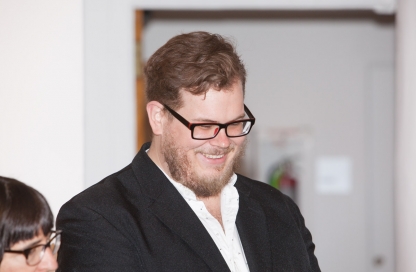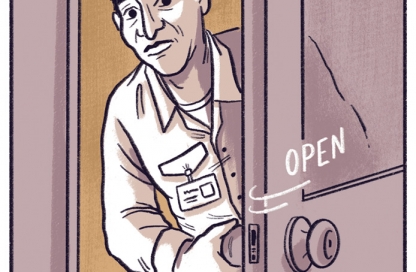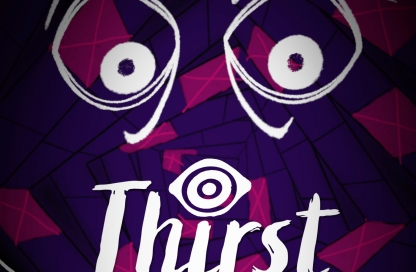Sweaty Palms is one of those ideas that makes you slap your head and think, “Why didn’t I think of that?” An anthology on anxiety by the top comic talent in the world just makes sense. A lot of us in the arts suffer from anxiety of varying degrees and we use visual storytelling to grapple with it. When Liz Enright (Class of 2017) told us about her Kickstarter for the project we knew she was onto something important. We got a chance to interview her to discuss anxiety, anthologies and Kickstarter!
Can you tell us about the moment you decided to move ahead with the project? What was the spark that made you say, “Let’s do this.”
The idea for the anthology was sparked by a conversation I had with my friend and co-editor Sage Coffey. She came over one day for what we like to call a “work party,” where we work on projects in the same room to combat the feelings of loneliness that seem to accompany the demanding cartoonist lifestyle. At the time my personal life was a mess and my social anxiety had reached new heights. Leaving my apartment made me uneasy, so it was comforting to be around somebody I trusted who could empathize with what I was going through. Sage and I had loosely discussed collaborating on an anthology. We’d look up from our work from time-to-time and throw topics around to see what would stick: a book about sitcoms or bad first dates were interesting enough ideas, but not meaningful enough to the both of us. As the evening progressed we started catching up and, naturally, opened up about our ongoing struggles with anxiety. That’s when it became crystal-clear that speaking freely about our mental health was not only empowering, it had the potential to be relatable to a large number of people. The very next thing we did was make a list of cartoonists we planned to invite to “Sweaty Palms.”
What was the response from the cartoonists when you asked them to join your project?
Their response was overwhelmingly positive! I didn’t expect many of the cartoonists would even have the time to participate. It came as a surprise to us when a majority of them made room in their busy schedules to contribute. Especially since the project required they expose something deeply personal about themselves to the world. But I think they were happy to share their stories because they understand what it’s like to feel silenced or hopeless while living with anxiety. We really lucked out with how generous our contributors have been. They’re just as excited about the book as we are and that’s all we could have ever hoped for!

“Guilt”
Where is the project at right now? You just wrapped up your successful Kickstarter, but now what?
It seems the work is never truly complete! We’re juggling several tasks on any given week and trying to stay as organized as possible (with mixed results.) Currently I’m finalizing the layout and design of the book so we can send it off to the printer. Next on the list is uploading the book to digital platforms so those who missed the campaign can still enjoy our stories. On the less glamorous side of things, there’s always an email to write or itemized spending spreadsheet to update. Then there’s the mental acrobatics of figuring out where in my apartment to unload a palette of 1,000 books. In 2017 the plan is to promote Sweaty Palms at shows to raise money for volume 2 and keep the project afloat!

“It Starts As A Seed”
Wow, so the storytellers have completed all their work! Amazing. Did you need to be far along to start the Kickstarter? You’ve gone the Kickstarter route before. Can you share some good advice for anyone out there who has been thinking about raising money this way?
Backers place an awful lot of trust in creators when pledging to a campaign. The more finished work you can show on the Kickstarter the more likely they are going to trust your ability to deliver on your promise. Having the pages in hand means a quicker turnaround from the time the campaign ends to when backers can enjoy the project. It’s one less thing to worry about while the campaign is running.
If you’re interested in launching a campaign Kickstarter’s
Creator Handbook is a great starting point. The site also has its own
forum for creators to discuss ideas. You might just find the answer to your questions there.

“The Beast”
As for my own advice:
Things I wish I’d known before launching a campaign:
1. Get organized
You’ll save yourself a major headache if you do your homework before the campaign is ever launched. Make a spreadsheet of contacts several months out. Create a mailing list with those names and grow it with a newsletter service like
TinyLetter. Do your research to see who might be interested in reviewing or featuring your project and send a press kit before the campaign is live. Give reviewers plenty of time write up your project. Give yourself plenty of time to secure backups if those outlets are disinterested or busy. Have your campaign images and video ready to go weeks in advance so you can get feedback from others. You’ll want to create a real buzz around the time you launch the project.
2. Back it up!
Back projects in your category to see what’s working and what isn’t. Take notes. You can learn just as much from a campaign that is unsuccessful as one that exceeds its goal. Backing also shows you’re an active part of the community.
3. Communication
Projects create small communities of people who are really passionate about the wonderful thing you’re putting out into the world! It’s bad form to ask for a lot of money without communicating what’s going on behind the scenes. Besides, posting regular updates is a great way of engaging your community. Updates can be used to share process or offer an exclusive look at content. We frequently embellished our posts with panels from the book or entire stories to keep interest up. A more interactive approach would be to create a poll. Maybe your comic book campaign wants to add a variant cover and needs backers to decide who will illustrate it. In my last campaign I offered small sketches in the front of the book and asked backers to post what they’d like drawn. Being present is just as important as being honest. If there are production delays or a family emergency just be frank about why the product isn’t going to meet the deadline. People are super understanding of this. They’re less understanding if you disappear without an explanation.
4. Smart packaging
Look into shipping rates in advance. International shipping is costly, so I’ve found it helpful to limit the size of rewards so everything fits into one, neat package. Pad your shipping budget in case items are returned or missing. This does happen and it can quickly add up!
5. Set boundaries
Running a campaign is downright nerve-wracking. My mood on any given day was often affected by how well or poorly the project was doing. The Kickstarter App is a great resource for creators but it certainly fed into my stress. One “ding!” for every pledge is almost intoxicating, but It’s also a huge distraction when you’re trying to get work done or rest. Create boundaries for yourself by having a posting schedule. Turn off notifications on your phone or enable “Do Not Disturb” mode if you’re and iPhone user to eliminate noise. No need to jump out of bed at 3:00 am to answer a message or post an update (I’ve been there and it’s not pretty). It can wait.
You’re working on your thesis now. How has this process informed your work? For instance, has it made you more ambitious? Has it made you more eager to work with people on your projects?
Sweaty Palms has definitely informed my art practice. I was inclined to think that a school/day job/freelance balance was impossible to achieve. After successfully chipping away at the project on top of all of my other obligations I’ve reconsidered the way I schedule work for myself. For instance, right now I’m trying to break my thesis down into small, manageable tasks. A reasonable daily to-do list is significantly less overwhelming than approaching a deadline without a plan. I’m not sure why it’s taken me this long to come around to the idea of making my life easier. Sweaty Palms has been the most uncomfortable artistic endeavor of my life. It’s also proven to be the most rewarding. Like many artists, I’m often combating that nagging voice that says, “They won’t like your work,” or “That’s a terrible idea.” The only way I’ve found to shut down the fear of failure is by putting myself out there. That fear was alive and well right up until we launched the campaign…I had second thoughts about recording the Kickstarter video. (Okay, maybe there was a minor emotional meltdown.) I dreamt of hiring an actress to take my place. I hoped to locate a perfectly Liz-shaped cactus to hide behind. I wished for an anvil to fall from the sky and put me out of my misery. Anything was better than being in front of a camera. After a few stilted recordings it dawned on me that people wouldn’t get behind the work if I didn’t appear to believe in what I was producing. I think the passion only came across in later takes when Sage and I let loose and embraced our goofier aspects. I’m willing to challenge my comfort zone again in order to promote my thesis and future projects.
Thanks so much for talking to us, Liz!






